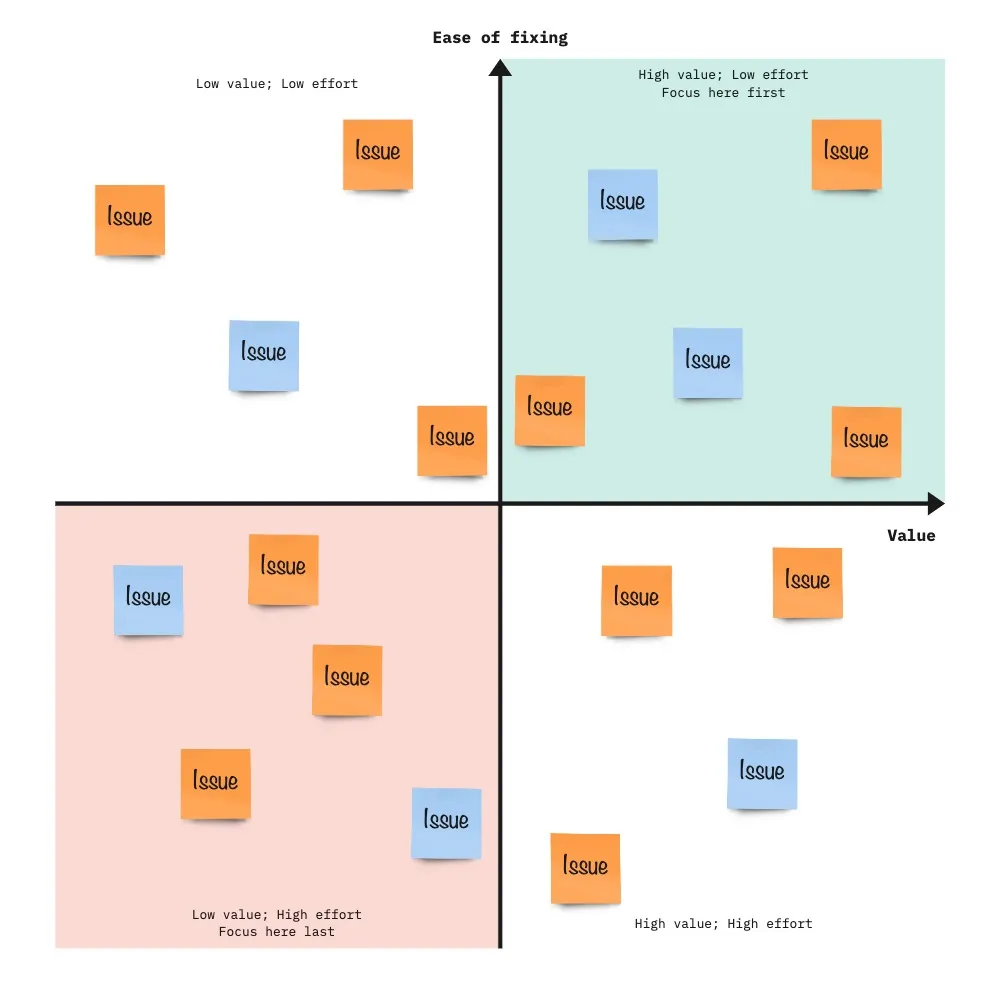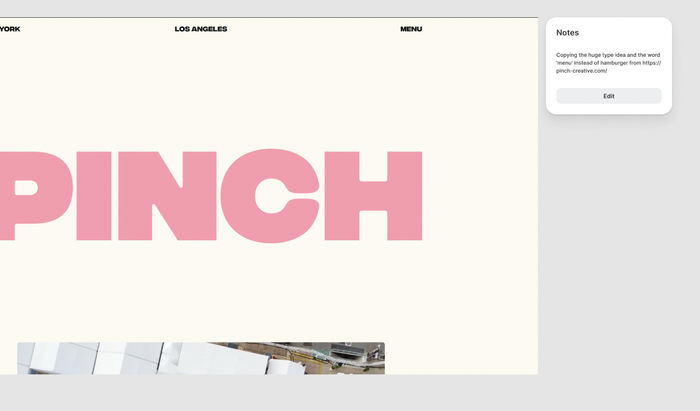Three things I'm doing to improve my design practice
Table of contents:
- TL;DR
- Identify and manage design debt
- Improve my design annotations \& decision documentation
- Design effective workshops
- Lessons \& takeaways
- Further reading
In recent months I upgraded the way I work, which took my design practice to the next level. These are three ways I’m improving it further.
TL;DR
- Identify and manage design debt. I plan to implement a strategy of managing design debt by preventing it through process improvements, collaborative identification, and development collaboration.
- Improve my design annotations & decision documentation. A simple way to build a stronger relationship with developers and stakeholders is to add notes to Figma boards highlighting the reasoning for design decisions.
- Design effective workshops. Continuing with my mission of facilitating useful, productive and enjoyable workshops. By adapting structures by AJ&Smart and Liberating Structures to design project-specific workshops.
Identify and manage design debt
What is design debt? Design debt, akin to technical debt in software development, refers to the compromises made in product design that, over time, can degrade the overall user experience. This could be imperfect navigation as features are built separately, janky user flows that stem from not understanding the end-to-end user journey fully or compromised components due to lack of capacity in an earlier phase.
The biggest lie in software is Phase Two
– Jeff Gothelf & Joshua Seiden Lean UX
Design debt can also affect processes like outdated or incomplete design systems, poor design documentation or unclear design development collaboration. Or suboptimal processes in general left to snowball without attention.
Why is design debt important? As design debt accumulates, inconsistencies mount, leading to disjointed user journeys and a decline in overall product quality. This results in user dissatisfaction and frustration. Moreover, the cost of addressing these issues later, along with the potential devaluation of the brand and product reputation, far outweighs the effort of proactively managing the design debt.
How I plan to tackle design debt I design with Lean UX principles, which helps mitigate some design debt, but design debt is unavoidable. So a strategy to help will be a good foundational element to build upon.
Strategy
- Identify
- Perform a UX Audit
- Creating a collaborative design debt board. A space where anyone can contribute design debt issues and provisionally score them for effort & impact.
- Set up a process for documenting design debt
- Prevention by establishing a solid design system foundation. The building blocks of a design system that defend against design debt are:
- Design tokens
- Type system
- Base rules: Error handling, component rules and documentation
- Design system management
- Prevention by process implementation
- Regular user testing
- Set up a process for discussing design debt. This could be a semi-regular catch-up with design, product and dev
- Set up a process for incorporating design debt into tickets
- Improve existing design debt – Taken from this gem, Five steps for tackling design debt
- Categorise existing debt
- Area (page, component etc)
- Journey (search, check-out etc)
- Type (fix, improvement, innovation etc)
- Design area (UX, UI, content etc)
- Prioritise
- A simple effort impact matrix is a good way to prioritise
- Workshop with team other ways to prioritise
- Plan
- Bugs that developers can start fixing right away
- Inconsistencies that need a quick design review
- Improvements that need further design work and testing
- Innovations that are new features which need to be researched, designed and tested
 Image from Five steps for tackling design debt
Image from Five steps for tackling design debt
Addressing design debt is an ongoing and essential task for any product team. Planning, implementing and reviewing a strategy for managing this is something I’ll be writing about in the coming weeks and months.
Proactive management of design debt ensures that a product remains consistent, user-friendly, and ahead of the curve. Left unchecked, the design debt becomes more challenging and costly to rectify.
Improve my design annotations & decision documentation
This is not about design documentation, at least in the traditional sense. I am an advocate for a solid design documentation process and it’s something I will be working on at RCN. Here, I’m specifically referring to clearly documenting my thought process and annotation during the design or research phase.
I like to make the design process as collaborative as I can, so everyone involved informs the design as much as the research, usability testing or I do. However, I do make key choices based on my knowledge and experience.
Why I chose this component over that, why cards over a table, and how accessibility is taken into consideration etc. There are times when I might have to defend a choice I’ve made to a product owner or developer. These meetings take time. A clearly documented decision process in Figma would save time for everyone involved.
There are times when I might have to defend a choice I’ve made to a product owner or developer. These meetings take time. A clearly documented decision process in Figma would save time for everyone involved
A simple solution for this is to add notes to Figma or another design tool as I design. The ability to link out is handy. I might want to link to a research study that informed my decision, or visual inspiration. A short note describing my thinking is all it takes.
There are several note widgets that are quite nice, and I’ve found that having a note in its own component slows me down enough to think and write.
 Notes app in use on inspiration used for Lloyd Evans • Design
Notes app in use on inspiration used for Lloyd Evans • Design
As well as documenting my decisions while designing, for the benefit of the team. I plan to work on a place for my reference when revisiting the project will be useful if I ever need to communicate the UX narrative. I often begin keeping notes at the start of a project. But as the workload increases, these notes slip.
Keeping a database of notes on designs would make the process of bringing the project back to mind when working on my portfolio or communicating designs to interviewers or even stakeholders within the organisation.
This improvement – Improve my design decision documentation – is back to basics design school stuff, but it’s a cornerstone often overlooked in the rush of delivery. Striking the right balance between speed and comprehensive documentation is the key to sustainable design practices.
Design effective workshops
Building upon my incorporation of workshop facilitation into my design practice, I want to take it a step further and learn how to design my own structured workshops that help us get ideas and make decisions faster.
This is something I’ve tinkered with previously. But guided - quite strictly - by the content produced by AJ&Smart, a renowned design agency known for its innovative workshop structures.
I trimmed the already shortened Design Sprint 2.0, from 4 days to 3. And the in-office collaborative session down to an afternoon. But this is due to the specific problem and careful examination of our needs.
After the success of the design sprint, I adopted their Lightning Decision Jam - LDJ, a workshop structure for solving problems in an hour workshop. And used it for all applicable projects. Until I tweaked it to better fit the needs of a specific project.
The Design Sprint and LDJ are fantastic workshop structures that I’ll continue to utilise. But with ‘The Surprising Power of Liberating Structures’ in hand, I’ll delve deeper into innovative workshop designs.
Liberating Structures offers a collection of workshop blueprints crafted for varied occasions. Though it might seem like a dense tome upon initial perusal, I recognize its potential as a goldmine of methodologies. I’m eager to integrate these strategies into my workshops at RCN as I embark on my journey there in November.
Lessons & takeaways
- Addressing design debt promptly prevents product inconsistencies, ensures user satisfaction, and reduces long-term costs.
- Proactively documenting design decisions and rationales can streamline collaborations, reduce potential misunderstandings, and serve as a future reference.
- Design workshops are platforms to gather collective expertise, making decisions faster and more collaboratively. Engaging stakeholders in the design process leads to more informed and aligned design decisions.
Further reading
Design debt:
- Managing and Mitigating Design Debt: A Solo UX Designer’s Guide Free article ✌️
- UX Debt: How to Identify, Prioritize, and Resolve Free article ✌️
Design annotations:
- Design annotations that will make your team metrics focused Free article ✌️
- Design annotations that will make your developers happy Free article ✌️
Designing workshops: